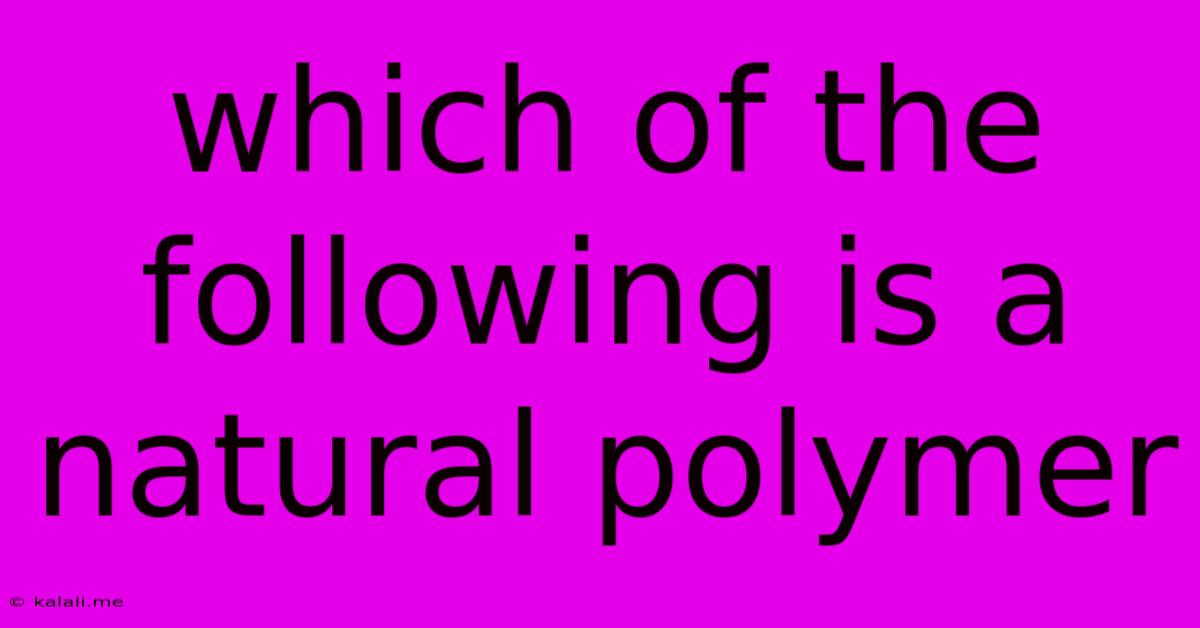Which Of The Following Is A Natural Polymer
Kalali
Jun 14, 2025 · 3 min read

Table of Contents
Which of the Following is a Natural Polymer? Understanding Natural vs. Synthetic Polymers
This article will explore the fascinating world of polymers, focusing specifically on the difference between natural and synthetic polymers and helping you identify which of a given list might be a natural polymer. Understanding this distinction is crucial in various fields, from materials science to biology. We'll delve into the characteristics of natural polymers and provide examples to solidify your understanding.
What are Polymers?
Polymers are large molecules composed of repeating structural units called monomers. These monomers are linked together through a process called polymerization, creating long chains or networks. The properties of a polymer depend heavily on the type of monomer, the length of the chain, and how the chains are arranged.
Natural vs. Synthetic Polymers:
The key difference lies in their origin.
-
Natural Polymers: These are polymers found in nature, produced by living organisms. They are often biodegradable and renewable. Examples include proteins, carbohydrates, and nucleic acids, all essential components of life.
-
Synthetic Polymers: These are polymers manufactured artificially through chemical processes. They are typically derived from petroleum or other fossil fuels and are often non-biodegradable. Examples include polyethylene (plastic bags), nylon (clothing), and polyester (clothing and bottles).
Identifying Natural Polymers:
Identifying a natural polymer often involves understanding its source and composition. Look for substances that are produced by living organisms, such as plants or animals. Let's examine some common examples:
-
Proteins: These are essential biomolecules composed of amino acid monomers. Examples include collagen (found in skin and connective tissues), keratin (found in hair and nails), and enzymes (catalysts in biological reactions). Proteins play crucial roles in structure, function, and regulation within living organisms.
-
Carbohydrates: These are made up of sugar monomers, including glucose, fructose, and galactose. Examples include cellulose (found in plant cell walls), starch (found in plants as an energy storage molecule), and glycogen (found in animals as an energy storage molecule). Carbohydrates provide energy and structural support.
-
Nucleic Acids (DNA & RNA): These are crucial for genetic information storage and transfer. They are composed of nucleotide monomers, each containing a sugar, a phosphate group, and a nitrogenous base. DNA carries the genetic blueprint, while RNA plays various roles in gene expression.
-
Natural Rubber: This is a polymer obtained from the sap of rubber trees ( Hevea brasiliensis). It's a flexible and elastic material with many uses.
Examples & How to Determine if a Polymer is Natural:
Let's consider a hypothetical scenario: You are given a list of polymers: cellulose, nylon, polyethylene, and starch. To identify the natural polymers, consider the source and composition.
- Cellulose: This is a structural component of plant cell walls, making it a natural polymer.
- Nylon: This is a synthetic fiber, manufactured artificially.
- Polyethylene: A common plastic, synthetically produced.
- Starch: An energy storage molecule in plants, a natural polymer.
Therefore, in this example, cellulose and starch are the natural polymers.
Conclusion:
Distinguishing between natural and synthetic polymers requires understanding their origins and composition. Natural polymers are produced by living organisms and often biodegradable, while synthetic polymers are artificially manufactured. By understanding the characteristics of each type, you can accurately identify natural polymers from a given list. This knowledge is essential in various scientific fields and contributes to a deeper appreciation for the complexity of materials in the natural world and those created by human ingenuity.
Latest Posts
Latest Posts
-
Which Of The Following Is Known As The Master Gland
Jun 14, 2025
-
Difference Between Seed Germination And Seed Emergence
Jun 14, 2025
-
Blood Is A Type Of What Tissue
Jun 14, 2025
-
Bureau Of Indian Standards Recruitment 2024
Jun 14, 2025
-
What Is The Jelly Like Substance In A Cell
Jun 14, 2025
Related Post
Thank you for visiting our website which covers about Which Of The Following Is A Natural Polymer . We hope the information provided has been useful to you. Feel free to contact us if you have any questions or need further assistance. See you next time and don't miss to bookmark.